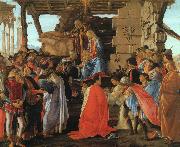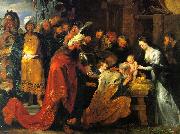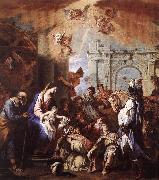
Oil On
Canvas, Real Flavor of Old Masters
|
Sandro Botticelli
|
|||
|
|
|||
| Italian Early Renaissance Painter, 1445-1510 Italian painter and draughtsman. In his lifetime he was one of the most esteemed painters in Italy, enjoying the patronage of the leading families of Florence, in particular the Medici and their banking clients. He was summoned to take part in the decoration of the Sistine Chapel in Rome, was highly commended by diplomatic agents to Ludovico Sforza in Milan and Isabella d Este in Mantua and also received enthusiastic praise from the famous mathematician Luca Pacioli and the humanist poet Ugolino Verino. By the time of his death, however, Botticelli s reputation was already waning. He was overshadowed first by the advent of what Vasari called the maniera devota, a new style by Perugino, Francesco Francia and the young Raphael, whose new and humanly affective sentiment, infused atmospheric effects and sweet colourism took Italy by storm; he was then eclipsed with the establishment immediately afterwards of the High Renaissance style, which Vasari called the modern manner, in the paintings of Michelangelo and the mature works of Raphael in the Vatican. From that time his name virtually disappeared until the reassessment of his reputation that gathered momentum in the 1890s | |||
|
|
|||
|
|
The Adoration of the Magi Sandro Botticelli6.jpg Painting ID:: 129 Visit European Gallery |
1475 Galleria degli Uffizi, Florence | |
Height Width |
INS/CM |
||
|
X |
|
||
|
|
|||
|
Peter Paul Rubens
|
|||
|
|
|||
| Flemish Baroque Era Painter, 1577-1640 Peter Paul Rubens (June 28, 1577 ?C May 30, 1640) was a prolific seventeenth-century Flemish Baroque painter, and a proponent of an exuberant Baroque style that emphasized movement, color, and sensuality. He is well-known for his Counter-Reformation altarpieces, portraits, landscapes, and history paintings of mythological and allegorical subjects. In addition to running a large studio in Antwerp which produced paintings popular with nobility and art collectors throughout Europe, Rubens was a classically-educated humanist scholar, art collector, and diplomat who was knighted by both Philip IV, king of Spain, and Charles I, king of England. Rubens was a prolific artist. His commissioned works were mostly religious subjects, "history" paintings, which included mythological subjects, and hunt scenes. He painted portraits, especially of friends, and self-portraits, and in later life painted several landscapes. Rubens designed tapestries and prints, as well as his own house. He also oversaw the ephemeral decorations of the Joyous Entry into Antwerp by the Cardinal-Infante Ferdinand in 1635. His drawings are mostly extremely forceful but not detailed; he also made great use of oil sketches as preparatory studies. He was one of the last major artists to make consistent use of wooden panels as a support medium, even for very large works, but he used canvas as well, especially when the work needed to be sent a long distance. For altarpieces he sometimes painted on slate to reduce reflection problems. His fondness of painting full-figured women gave rise to the terms 'Rubensian' or 'Rubenesque' for plus-sized women. The term 'Rubensiaans' is also commonly used in Dutch to denote such women. | |||
|
|
|||
|
|
The Adoration of the Magi Peter Paul Rubens1.jpg Painting ID:: 3641 Visit European Gallery |
1617-18 Musee des Beaux Arts, Lyons | |
Height Width |
INS/CM |
||
|
X |
|
||
|
|
|||
|
RICCI, Sebastiano
|
|||
|
|
|||
| Italian painter, Venetian school (b. 1659, Belluno, d. 1734, Venezia).Painter and draughtsman. He painted light and colourful religious, historical and mythological subjects with a fluid, painterly touch. His rediscovery of Paolo Veronese, whose settings and costumes he borrowed, was important to later Venetian painters. Sebastiano was an itinerant artist, celebrated throughout Europe. | |||
|
|
|||
|
|
The Adoration of the Magi new1/RICCI, Sebastiano12.jpg Painting ID:: 8922 Visit European Gallery |
1726-30 Oil on canvas, 330,2 x 289,6 cm Royal Collection, | |
Height Width |
INS/CM |
||
|
X |
|
||
|
|
|||
|
Maino, Juan Bautista del
|
|||
|
|
|||
| Spanish Baroque Era Painter, 1578-1649 | |||
|
|
|||
|
|
The Adoration of the Magi new5/Maino, Juan Bautista del_3xZaSD.jpg Painting ID:: 19250 Visit European Gallery |
Oil on canvas Museo del Prado, Madrid. | |
Height Width |
INS/CM |
||
|
X |
|
||
|
|
|||










